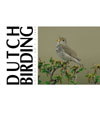Dutch Birding volume 27 (2005) no 5

Western Black-eared Wheatears on Terschelling in May 2001 and at Eemshaven in October-November 2004
On 11 May 2001, a 'black-eared wheatear' Oenanthe hispanica/melanoleuca was observed and photographed near Lies on Terschelling, Friesland, the Netherlands. It was seen by just four observers and was identified as a first-summer male Western Black-eared Wheatear O hispanica on basis of the photographs and description. The ageing was mainly based on the not fully black flight-feathers (because of pale tips and edges) and grey in the crown. Its identification as 'pale-throated 'black-eared wheatear' or Pied Wheatear O pleschanka' was straightforward because of the tail pattern with extensive black on the outer tail-feathers and more limited black on inner tail-feathers. The main characters pointing towards hispanica were the adult-looking plumage (first-summer male Eastern Black-eared Wheatear O melanoleuca looks more 'juvenile', especially on the coverts), very limited black on forehead above the bill (broader in melanoleuca), shape of the black ear patch (more extensive in melanoleuca), pale mantle appearing relatively broad (appearing narrower in melanoleuca) and relatively short primary projection (slightly longer in melanoleuca). In the field, the bird appeared slightly warmer buffish than on the accompanying photographs.
On 30 October 2004, a 'black-eared wheatear' was discovered at Eemshaven, Groningen, the Netherlands. It was identified as a pale-throated female hispanica and attracted 100s of birders on the first day and during the rest of its prolonged stay; it was last seen on 28 November. Identification was based on the typical 'black-eared wheatear' tail pattern (excluding all other wheatears except melanoleuca and pleschanka), very uniform sandy plumage with almost no contrast between upperparts and underparts (reminiscent of female Desert Wheatear O deserti; more contrasting in melanoleuca, upperparts darker and colder brown in pleschanka), lack of grey on the crown and relatively short primary projection. It was aged as a first-winter (having completed the post-juvenile moult) on the basis of the head pattern with limited dark on the lore, dark-brown (black in adult) and worn flight-feathers (fresher in adults because they moult later in summer/autumn). The greater coverts appeared to be unmoulted and still juvenile; although this is not uncommon, most first-winters have moulted one or more greater coverts and can be easily aged by the resulting moult contrast.
Both records have been accepted as hispanica by the Dutch rarities committee (CDNA); after revision of all 'black-eared wheaters' on the Dutch list (following the split of hispanica and melanoleuca and the publication of more detailed identification criteria), the CDNA concluded that previous records were no longer acceptable as hispanica. The record on Terschelling therefore becomes the first of this taxon and the record at Eemshaven the second. After the revision, three birds on the Dutch list are accepted as melanoleuca and five as hispanica/melanoleuca.
Enno B Ebels, Joseph Haydnlaan 4, 3533 AE Utrecht, Nederland (ebelswxs.nl)
Mark Zekhuis, Stoevelaar 23, 7414 CA Deventer, Nederland
(catbirdhome.nl)
Jacob G Bosma, Bekemaheerd 116, 9737 PX Groningen, Nederland
(jacobbosmatiscali.nl)
Martin P Olthoff, E Reitsmalaan 2, 9744 DK Groningen, Nederland
(martinolthoffhetnet.nl)
terug






